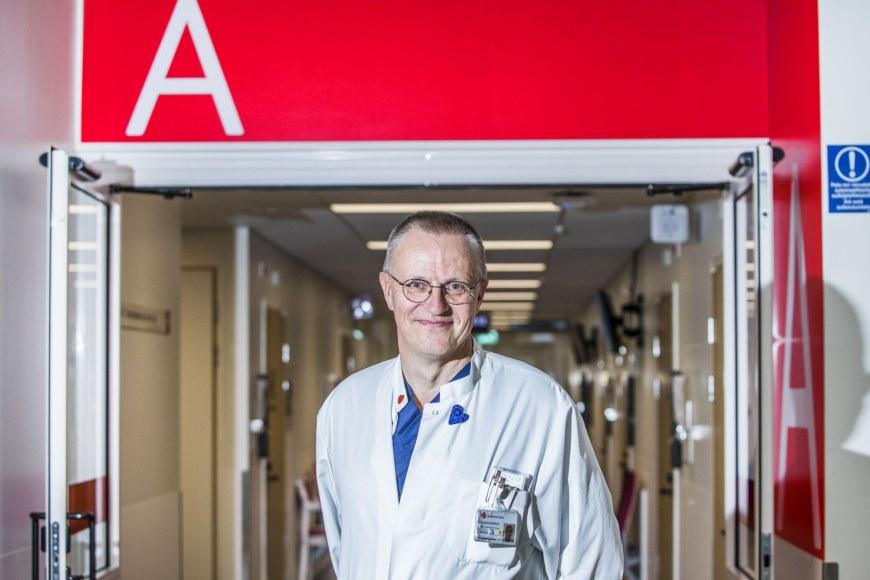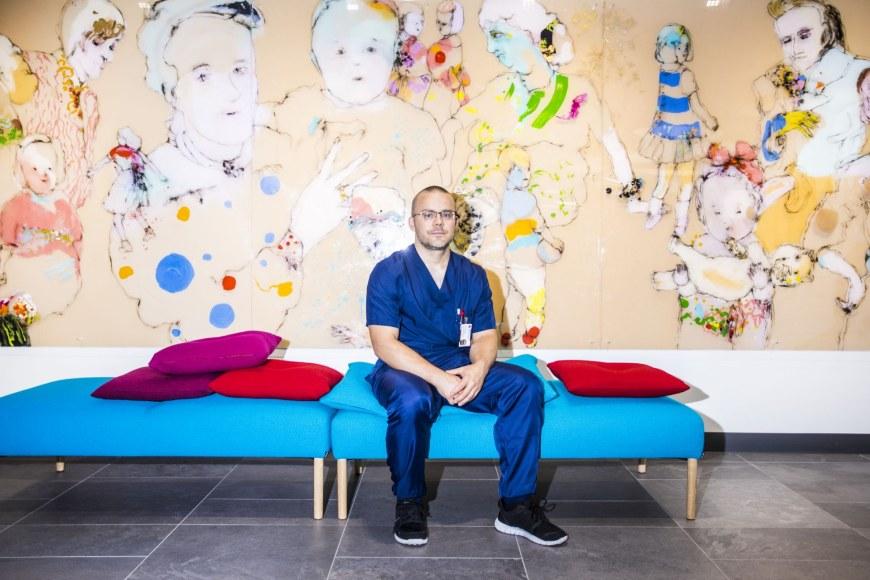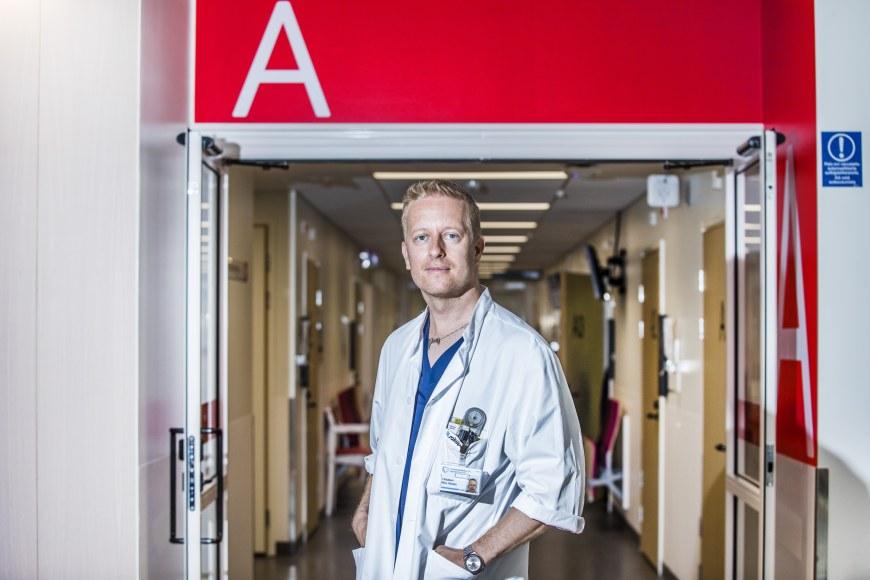Research is improving the safety of heart surgery

This article was originally published in Unit, the magazine of Tampere Universities.
Western populations are getting older, which means that more heart procedures are being performed than ever before.
Jari Laurikka, professor of cardiothoracic surgery, has operated on hearts for over thirty years. Over the years, he has witnessed the change with his own eyes. Patients who come for operations are getting older.
“Cardiac surgery patients used to be in their fifties, but now their average age is closer to seventy, while operations are performed even on some 80-year-olds,” Laurikka says.
The type of operations has also changed. The number of bypass operations has decreased while the number of aortic valve procedures has increased. The calcification of the aortic valve is a typical condition in older patients.
Even though patients are getting older and becoming more fragile, postoperative complications and deaths have not increased.
“In cardiac surgery, surgeons always fight against death, because heart diseases are so serious. However, we have managed to keep the mortality rate down,” Laurikka explains.
According to Laurikka, this success is not only due to surgeons. Rather, the entire team – from nurses to cardiologists, anaesthesiologists and physiotherapists, as well as the entire diagnostic chain – should be thanked.
Severe symptoms have decreased
With preventive and effective medication and improved lifestyles, severe heart disease has reduced throughout the Western world.
“Serious cases can be tackled by timely diagnosis and early treatment, which is the current trend in cardiac medicine. People still get ill and need medication, but they are not dying of acute heart disease as much as they used to,” Laurikka notes.
The most common heart operations are bypass and valve surgeries. The procedures have not changed much over the years, but protecting the heart, pre-examining the patients and preparing them for procedures have significantly improved.
Surgeons and cardiologists also have new tools. Most of these inventions are created by multidisciplinary research communities of medical and technology experts.

Better treatments with data
For some time, cardiac function has been monitored during operations by ultrasound through the oesophagus. However, when this method is used, the right ventricle of the heart cannot be seen properly. Laurikka’s research group and Mikko Hokka, assistant professor of mechanical behaviour of engineering materials at Tampere University, have developed a possible solution to the problem. They are conducting a study that records the heartbeat during surgery and converts the movements of the heart into numbers with a computational model.
The figures give the surgeon more accurate, real-time, visual information on the condition of the heart and help in planning postoperative care.
“It seems that we have a good chance of getting a practical tool for operating theatres," says Laurikka.
In an Academy of Finland-funded project, Niku Oksala, professor of vascular surgery at Tampere University, is developing wearable measuring devices that could travel with people unnoticed.
The ambitious by-product of his research entails very expensive technology, and it is still under development: it is an outpatient clinic where patients can be examined without attaching a single measuring device to them. New imaging technologies and advanced data analysis enable this.
A non-invasive outpatient clinic would bring many benefits. Attaching measuring devices causes problems with hygiene and infections and hampers the patients’ movements. However, Oksala’s most important motivation is that the clinic would allow more time for the care professionals to talk to the patient.
“Currently, outpatient clinics are like visiting a body shop to fix your car, because they attach all these wires to you. Instead being a measuring circus, hospitals should rather emphasise bedside manner,” Oksala explains.

Means to prevent sudden deaths
Those at risk of serious cardiac events still remain unidentified, which can have fatal consequences.
“Unfortunately, one of the most common first symptoms of coronary artery disease is sudden death,” says Jussi Hernesniemi, a cardiologist and adjunct professor at Tampere University who specialises in the treatment of coronary artery disease.
Currently, less than 20% of those at risk of sudden death can be identified and treated in time. The aim of Hernesniemi’s Business Finland-funded study is to improve the detection of patients who are at high risk of serious adverse events. The study has collected a wide range of data from patients at Tampere University Hospital’s Heart Hospital. The results will provide a more accurate picture of cardiac deaths and other serious cases, such as strokes. As part of the study, the electrocardiograms and home activity of myocardial infarction patients have been monitored and artificial intelligence has been used to analyse the data.
“There are several treatment options if we could only find the patients at risk in time. Beta-blockers are a well-tolerated medication and effective in preventing arrhythmias. If necessary, it is also possible to implant a cardioverter defibrillator,” says Hernesniemi.
The first signs of a stroke can also be seen in the heart. Atrial fibrillation is a cardiac arrhythmia that increases the risk of stroke fivefold. Even though devices to detect atrial fibrillation already exist, the condition often goes unnoticed until a stroke. Mobile monitors that measure the heart rate with light from the surface of the skin – such as the ones used in smart watches – are also very reliable in detecting atrial fibrillation. However, it is those with a very low risk of heart disease, ie active exercisers and athletes, who use these measuring devices the most.
“To put it bluntly, middle-aged people who are getting ready to retire and lead a sedentary lifestyle run the highest risk of a serious heart attack,” Hernesniemi points out.
If not done as an integral part of the patients’ lives, data gathering usually fails because it is always seen as a burden. However, advances in mobile technology offer opportunities to collect health information through applications that continuously monitor people’s health.
“When such applications become more common, data begin to accumulate, whether wanted or not. The big question is whether the data gathered by commercial operators can be used in medical research,” Hernesniemi says.
In the right place at the right time
Oksala, Laurikka and Hernesniemi emphasise that in order to get good results, it is important to know how to choose the right patients for the more expensive interventions. It is not that there is anything wrong with the other patients, but the timing of the surgery may be wrong.
Efforts are made to improve the way patients are prepared for operations so that potential problems can be addressed before the procedure in order to identify and consider risks. When the surgery is prepared for in advance, the patient can come to cardiac surgery directly from home the same morning. This is not only more pleasant, but also safer than waiting in the hospital.
“The hospital environment has strains of bacteria that stick to the skin, some of which can be harmful to patients,” says Laurikka.
“Society also saves money by not having patients sleep in places where they do not need to be,” he adds.
At the Heart Hospital, physiotherapists and health professionals other than surgeons also monitor the patients. Physiotherapists measure functional capacity and anticipate problems with recovery. Particularly in open-heart surgery, the physiotherapists’ contribution to the patient’s recovery is important.

Everything affects cardiac health
Impact studies have shown that the treatment of even very old patients is worthwhile. Interventions in the heart are expensive, but the results are good and can help maintain a person’s functional ability at home. This means direct savings to society, and – above all – it is important for the patients and their families.
“Cardiac treatments have many interfaces with family life. When we can help one person, successful care also has wider impacts,” Laurikka says.
The work of cardiovascular specialists is meticulous and technology offers new opportunities that all have the same goal: a thriving and self-sufficient patient. This is increasingly important now that many of us are living longer than ever.
“We will have more octogenarians, who can be active when they are healthy. However, when they fall ill, it has a big impact on their vital functions. Because an older patient’s recovery is no longer as complete as a younger patient’s, every incident permanently weakens the patient’s health,” Oksala says.
He sees human health as a whole that is influenced by other people, the community, and the environment. The effects can be delayed by dozens of years, which makes them hard to detect.
“How well people eat, how they live and how happy they are actually has an effect on cardiovascular health. It is absolutely vital to realise that people are not just biochemical machines,” Oksala points out.
New areas of research
- Healing of the sternum after open surgery. A study has developed a method based on the permeability of the sternum using vibration energy, which may be used to monitor the ossification of the sternum.
- Wearable measuring devices and a non-invasive outpatient clinic. Engineers, physicians and physicists from various disciplines are involved.
- Protecting the heart with the so-called quick stop technique. The study examines whether the heart is in a better condition after it has been rapidly stopped by medicinal substances during surgery.
- The first signs of sudden death from heart attack.
Collaboration between the university and hospital
- Tampere University Hospital’s Heart Hospital is a public hospital specialising in cardiovascular diseases.
- Tampere University’s Finnish Cardiovascular Research Center is a research hub. In addition to researching surgery and cardiology, its members also investigate genes and stem cells.
- Many professors of medicine also work at the hospital. Their working week includes patient care, surgery, the teaching of medical students, administrative duties and research. The professors’ dual role provides them with information on practical phenomena and problems in patient care that can be translated into research and the development of solutions.
Author: Tiina Lankinen








